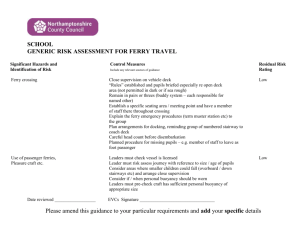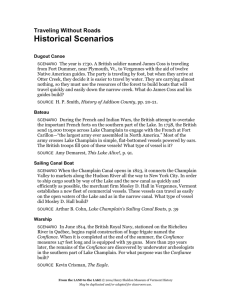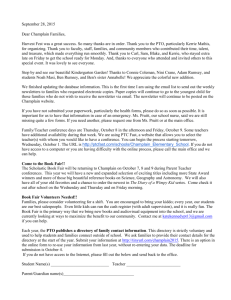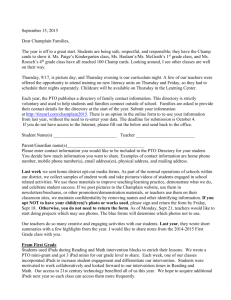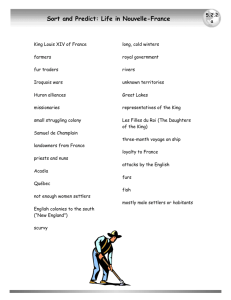History of the ferries owned by the Lake Champlain Transportation
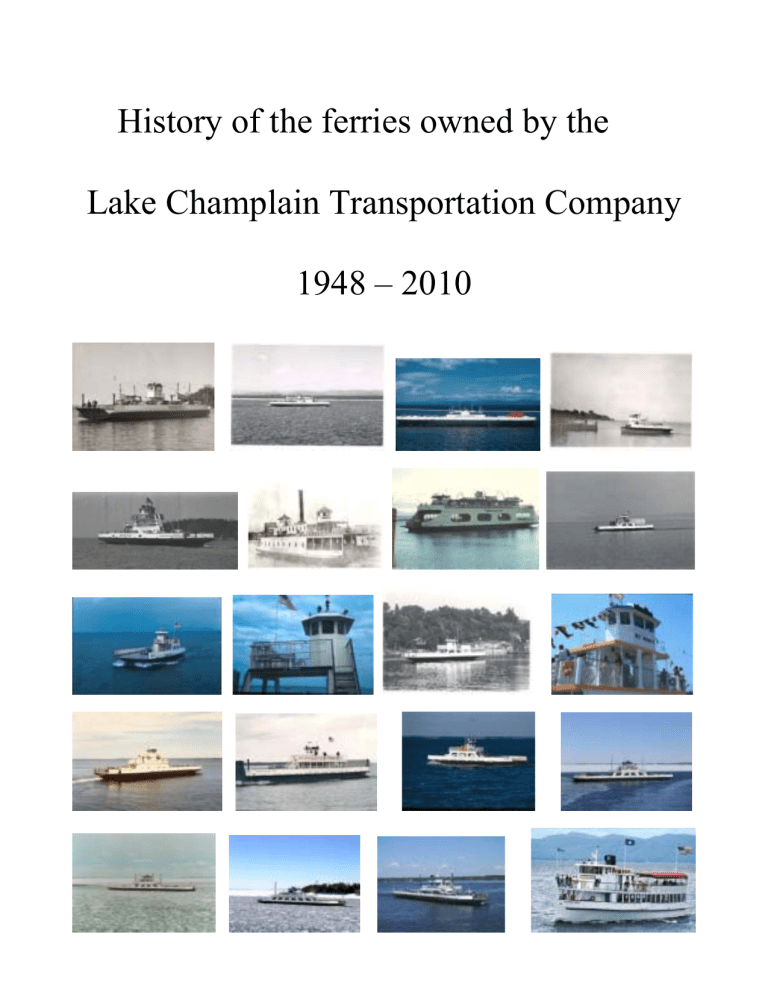
History of the ferries owned by the
Lake Champlain Transportation Company
1948 – 2010
Roosevelt
Built in 1923 in Nyack New York. A diesel screw ferry with a wooden hull, and 108 feet in length.
Two 4-cylinder engines of only 120 horsepower each powered her. Acquired with the purchase of the company. She ran on the Grand Isle to Cumberland Head crossing. In 1959, because of several leaks that nearly sank her overnight she was towed to mid lake and several holes chopped in her hull. Today she sits on her keel at the bottom of the lake.
Mott Haven
Built in Brooklyn New York and 99 feet in length. Arriving on Lake Champlain in 1945 after having served on the Riker’s Island run in New York. She was also acquired with the purchase of the company. The “Mott Haven” was powered by one Nelseco (The New London Ship and Engine
Company of Groton CT) diesel engine. The single 6-cylinder engine was a direct reversible, 250 RPM with 300 horsepower. These engines were the same as those used in our World War I diesel submarines. The “Mott Haven” sailed on the Burlington to Port Kent run with the “Valcour” and
“Adirondack” Her car capacity was only 15 cars and with a growing crossing she was to small for the company. She was sold to the A&P Grocery heir Huntington Hartford II in 1961. Huntington
Hartford II had just purchased the islet then known as Hog Island in the Bahamas. He had a 52-room hotel built plus 4 cottages, and called it the Ocean Club. The Island was renamed Paradise Island and became a first class resort. The “Mott Haven” was sent to Nassau to ferry his guests between Nassau and Paradise Island. However, in 1966 the venture proved too costly and Huntington Harrington II sold out. The “Mott Haven” was most likely scrapped.
Valcour
Built at Shelburne Shipyard in Shelburne Vermont in 1947. The “Valcour” was built by the old
Champlain Transportation Company and was acquired with the purchase of the Company. Built as a flat top with capacity of 50 cars, the passenger lounge and bathrooms are located below deck. Four
Clark 4 cylinder direct reversible engines powered the “Valcour”. There were two engine rooms with two engines in each. In 1990 the “Valcour” was re-powered on one end with a pair of D353 425 HP
Caterpillar engines. By re-powering only one end, “single ending her” and removing the forward propellers and rudder it made her a little faster in the water and a lot more economical to run. She still serves the Burlington-Port Kent crossing.
Juniper
Built in 1945 in Yonkers New York for the Pepsi Bottling Company. Formerly named the “Big
Bottle” A twin engine, single ended ferry used to carry Pepsi trucks across the Hudson River. She is powered by two 6V71 Detroit Diesel engines and is 63 feet in length. Purchased by Lake Champlain
Transportation Co. in 1948 and put to work on the Charlotte-Essex crossing. In 1970 she was sold to
Bill Scott a local crane operator who used the Juniper for work and pleasure. The Juniper changed ownership again in 1976 when Frank Pabst purchased her to use as a tug/workboat/dinner cruise boat.
When not cruising, Frank Pabst would be rescuing stranded boats and doing dockside work. In 2001 the “Juniper” was sold to a local doctor for personal use. In 2005 the “Juniper” made her final voyage down Lake Champlain to the Champlain Barge Canal and on to Troy New York to be scrapped.
Grand Isle
Built in Tampa Florida in 1953 for Lake Champlain Transportation. The Grand Isle, at 132 feet would become the newest vessel to join the fleet at the Grand Isle-Cumberland Head crossing. A true double ender, she was powered by two Buda diesel engines. Over the years the Grand Isle would go through some major changes. In 1963 two new Caterpillar D353 450 HP engines were installed. In 1973 the main deck was widened to accommodate larger trucks. Over the next several years the trucks became longer and in 1995 the Grand Isle was sailed to Panama City Florida where a local shipyard cut the
Grand Isle in half and installed a 38-foot mid body and reconfigured her superstructure. A lounge and new bathrooms were also installed. Her new length was now 169 feet. In 2003 a pair of new
Caterpillar 3412E 503 HP engines were installed. The Grand Isle now runs at the Charlotte-Essex crossing.
Adirondack
Built as the “South Jacksonville” in 1913 at the Merrill-Stevens shipyard in Jacksonville Florida for the Jacksonville Ferry and Land Company. The 130-foot double-ended ferryboat had a 40-foot beam and was powered by a coal-fired steam engine. She was put into service on the Saint Johns River between downtown Jacksonville and South Jacksonville. A bridge (a ferryboats worst enemy) was built in 1921 and the boat was no longer needed. She was sold to the Tocony-Palmyra Ferry Company of Philadelphia and put into service on the Delaware River under the new name “Mount Holly” In th Street 1927 the “Mount Holly” went further north, to New York Harbor. Her new owners, the 34
Vehicular Ferry Company kept the name “Mount Holly” and put her into service on the East River between Long Island City and the foot of East 34 th Street in Manhattan. The company failed in 1936 when the “Mount Holly” was a quarter of a century old. The national economy was in the midst of the
Great Depression. New bridges and tunnels were eliminating the need for ferryboats up and down the east coast, making her future gloomy indeed.
Yet the “Mount Holly” survived. On May 5, 1938, the expanding Chesapeake Bay Ferry
Company purchased her. Major rebuilding of the superstructure was done at this time, giving her, to a large extent, the appearance that she has today. She was renamed the “Governor Emerson C
Harrington II” and ran on Eastern Bay on the Chesapeake, connecting the communities of Clairborne and Romancoke. The company was taken over by the State of Maryland in the early forties.
In 1945, The “Governor Emerson C. Harrington II” was sent to the Baltimore Marine Repair
Shops where her original steam and coal fired boilers where removed and replaced with a pair of 6cylinder Atlas Imperial diesel engines.
The first span of the Chesapeake Bay Bridge opened in the summer of 1952 and the State of
Maryland ceased its ferryboat operations. The “Governor Emerson C. Harrington II” was for sale again.
The Lake Champlain Transportation Company, of Burlington Vermont, purchased the
“Governor Emerson C. Harrington II” in 1954. The ferryboat that was about become the
“Adirondack” (named for the mountain range in Upper New York State) entered a shipyard in Troy
New York where her upper deck was disassembled and lowered to the car deck. This was done so she could be brought up the Champlain Canal with its low bridge clearances (13 feet) to Lake Champlain.
The “Adirondack’s” second deck was restored to its original position in Burlington, where she began the current phase of her extraordinary and colorful career.
The “Adirondack” has sailed every summer between Burlington and Port Kent since 1954. Her only major modification during this time was the replacement of the Atlas Imperial engines with two-
12V71 Detroit Diesel in 1970.
The “Adirondack” is the oldest, in service, double-ended American ferryboat of all time! On
January 15, 2013 the “Adi” will celebrate her 100 th birthday.
Champlain
Built in 1930 as the “City Of Hampton” in Baltimore Maryland with a length of 148 feet. The “City
Of Hampton” is powered by one 550 HP direct reversible diesel engine. The pistons have a 14” bore
X 17” stroke with a maximum RPM of 250. With the opening of several bridges and tunnels The
“City Of Hampton” became one of several ferries to be disposed of by the Virginia Department of
Highways in 1957. The “City Of Hampton” ran in Hampton Rhodes on a crossing from Old Point
Comfort (Fort Monroe) to Willoughby on the Norfolk side. Part of the crossing was in shallow water so the “City of Hampton” was built with a flat bottom. Lake Champlain Transportation purchased the
“City Of Hampton” in November of 1957 and made arrangements for her to be towed from Norfolk
Virginia and Waterford New York. While in Waterford the upper deck was carefully cut loose and lowered onto the main deck. This would give her enough clearance to pass under the low bridges during the northward trip to Lake Champlain. Renamed the “Champlain”, she joins the “Valcour” and the “Adirondack” on the Burlington to Port Kent crossing.
E
ssex I
Built in 1966 by Blount Marine in Warren Rhode Island. Built to Lake Champlain Transportations specifications, The “Essex” a double-ended ferry at 63 feet in length and a capacity of 9 cars was built to join the “Juniper” on the Charlotte-Essex crossing. The ”Essex” was powered by one 12V-71
Detroit Diesel engine. The engine was mounted off to one side of the keel and turned a jackshaft, which drove two big 12-inch wide belts that ran to an air clutch. There was an air clutch for each propeller shaft (one for each direction). When air was introduced to the clutch a membrane in the clutch would expand and cause the propeller shaft to turn. This was a very cost effective and easy propulsion system requiring very little maintenance. The problem was the propeller shaft could only be turned in the “ahead” direction. However, it was soon evident that the “Essex” was to small, and in
1970 the “Essex” was sold to Puerto de Galves, Guatemala.
Abnaki
A double-ended 80-foot, 12-car ferry built in 1967 by Blount Marine in Warren Rhode Island. Built to
Lake Champlain Transportations specifications, the “Abnaki” joined the “Essex” on the Charlotte-
Essex crossing. The arrival of the “Abnaki” spelled doom for the “Juniper” which was sold to a local crane service to be used for work and pleasure. The ”Abnaki” was powered by one 12V-71 Detroit
Diesel engine. The engine was mounted off to one side of the keel and turned a jackshaft, which drove two big 12-inch wide belts that ran to an air clutch. There was an air clutch for each propeller shaft
(one for each direction). When air was introduced to the clutch a membrane in the clutch would expand and cause the propeller shaft to turn. This was a very cost effective and easy propulsion system requiring very little maintenance. The problem was the propeller shaft could only be turned in the
“ahead” direction. The increased popularity and majestic beauty of the Charlotte-Essex crossing rendered the “Abnaki” to small to handle the increased traffic. In 1970 the “Abnaki” was sold to the
State of Alaska. In order to pass under the low bridges in the Champlain Canal the top half of the pilothouse was removed and lowered onto the main deck. The “Abnaki” began a 7600-mile journey south down the Champlain Barge Canal, on to the Hudson River to Albany New York, where the top half of the pilothouse was reinstalled. Then on to New York City and southward along the east coast, west through the Panama Canal, and north to Ketchikan Alaska. Renamed the “Dick Borch” she was used to ferry passengers and vehicles between the mainland and Ketchikan International Airport on
Gravina Island.
Algonquin
Another double-ended 80 foot, 12-car ferry built in 1968 by Blount Marine in Warren Rhode Island.
Built to Lake Champlain Transportations specifications, the “Algonquin” joined the “Grand Isle” on the Grand Isle-Cumberland Head crossing. The ”Algonquin” was powered by one 12V-71 Detroit
Diesel engine. The engine was mounted off to one side of the keel and turned a jackshaft, which drove two big 12-inch wide belts that ran to an air clutch. There was an air clutch for each propeller shaft
(one for each direction). When air was introduced to the clutch a membrane in the clutch would expand and cause the propeller shaft to turn. This was a very cost effective and easy propulsion system requiring very little maintenance. The problem was the propeller shaft could only be turned in the
“ahead” direction. In 1974 the “Algonquin” was sold to the State of Alaska to join her sister ship the formerly named “Abnaki”. In order to pass under the low bridges in the Champlain Canal the top half of the pilothouse was removed and lowered onto the main deck. The “Algonquin” began her 7600mile journey south down the Champlain Barge Canal, on to the Hudson River to Albany New York, where the top half of the pilothouse was reinstalled. Then on to New York City and southward along the east coast, west through the Panama Canal, and north to Ketchikan Alaska. Renamed the “Ken
Eichner” she was used to ferry passengers and vehicles between the mainland and Ketchikan
International Airport on Gravina Island.
Mt Mansfield
Built in 1969 to Lake Champlain Transportations specifications, by Blount Marine in Warren Rhode
Island the “Mt Mansfield” a double-ended 100-foot, 21-car ferry. Built to replace the Alaska bound
“Abnaki” the larger “Mt Mansfield” was put to work on the Charlotte-Essex crossing. She was also powered by one 12V-71 Detroit Diesel engine. The engine was mounted off to one side of the keel and turned a jackshaft, which drove two big 12-inch wide belts that ran to an air clutch. There was an air clutch for each propeller shaft (one for each direction). When air was introduced to the clutch a membrane in the clutch would expand and cause the propeller shaft to turn. This was a very cost effective and easy propulsion system requiring very little maintenance. The problem was the propeller shaft could only be turned in the “ahead” direction. In 1979 to 1982 the “Mt Mansfield” was sent to
Pensacola Florida. She was re-powered with two Caterpillar 3406 diesel engines with Twin Disc MG-
514 transmissions. The “Mt Mansfield” was used to ferry passengers and vehicles while a bridge that was hit by a freighter was being repaired. In 1982 to 1989 she was used on the Dauphin Island – Fort
Morgan ferry crossing on an east west route in Mobile Bay. The “Mt Mansfield” sat idle in the Mobile
Bay area from 1989-1991. Then in 1992 she was sold to the Delaware River Authority Re-named the
“Riverlink” and converted into a water taxi. The car deck was enclosed to carry passengers from
Philadelphia PA to Camden NJ. In 2004 she was sold to Prudence Island Ferry Inc. in Bristol Rhode
Island to be converted back to a car ferry, carrying vehicles and passengers between Bristol and
Prudence Island.
Mt Marcy
Built in 1971 to Lake Champlain Transportations specifications, by Blount Marine in Warren Rhode
Island the “Mt Macy”, a double ended 100-foot, 21 car ferry. She was built with a 2nd deck, with an enclosed heated lounge for passengers. In the engine room there was a generator used to provide electric heat for the bathroom, passenger lounge, and pilothouse. The main engines were a pair of
Detroit 12V-71 diesel engines coupled to a Twin Disc MG-514 marine transmission. Equipped with a hydraulic steering system and radar, the “Mt Marcy” was a very comfortable boat to operate. Joining the “Mt Mansfield” on the Charlotte-Essex crossing the “Mt Marcy” was a welcome addition to a growing crossing. In 1979 hurricane Fredrick took out a causeway between Mobile Alabama and
Dauphin Island. The “Mt Marcy” was sent to provide a connection between Mobile and Dauphin
Island until the causeway was repaired. 1982 found the “Mt Marcy” back on Lake Champlain running between Charlotte Vermont and Essex New York. Five years later in 1987 she would follow the path of the “Abnaki” and “Algonquin” to Ketchikan Alaska. After carefully removing the top half of the lounge and pilothouse, and installing temporary controls she set sail for Albany New York via the
Champlain Barge Canal and Hudson River. While in Albany the lounge and pilothouse were reinstalled for the 7600-mile voyage to Ketchikan. Sailing down the Hudson River to New York City and then southward along the east coast, west through the Panama Canal, and north to Ketchikan
Alaska. Renamed the “Bob Ellis” she was used to ferry passengers and vehicles between the mainland and Ketchikan International Airport on Gravina Island.
Governor George D. Aiken
Built in 1975 to Lake Champlain Transportations specifications, by Blount Marine in Warren Rhode
Island. Named after a former Governor of Vermont. The “Aiken” is a 132-foot double-ended ferry, equipped with a heated bathroom, passenger lounge, and outdoor seating on the lounge deck. The
“Aiken” can carry up to 26 cars and is built strong enough to carry large trucks up to 40 tons. In the engine room are two Detroit 12V-71 diesel engines coupled to a Twin Disc MG-514 marine transmission and a 20 KW generator provides the electrical power. Equipped with a hydraulic steering system and radar, the “Aiken” joined the “Grand Isle” on the Grand Isle-Cumberland Head crossing.
Now the “Aiken” and the “Grand Isle” are operating on the Charlotte-Essex crossing.
Charlotte / Bayfield
Built in Baltimore MD in 1952 the 91 foot then named “Langley” was used as a research vessel by the Virginia Institute of Technology. Lake Champlain Transportation purchased her in 1980. Renamed the “Charlotte” and converted to a car ferry, she was put into service on the Charlotte-Essex crossing. A direct reversible 5 cylinder Fairbanks Morse diesel engine powered the “Charlotte”. The engine was pilothouse controlled so the captain could start, stop and control the speed of the engine as needed. In October of 1984 she was leased to Canada to fill in for a ferryboat that was in need of repair. The “Charlotte” sailed up to Pilleys Island, Newfoundland to transport passengers and vehicles on a 2500-foot crossing. In June of 1985 the “Charlotte” was sent directly from Newfoundland to
Mobile Bay to join the “Mt Mansfield” on the Dauphin Island-Fort Morgan ferry crossing. In 1986 the
“Charlotte” was sent to Panama City Florida where she was re-powered with two caterpillar 3406 diesel engines, and a mid body was inserted making her 112 feet in length. The superstructure was reconfigured to make access to the engine rooms easier and a cleaner more functional car deck. The
“Charlotte” found herself back on Lake Champlain on the Charlotte-Essex crossing in 1990. The
Madeline Island Ferry Line in Northern Wisconsin was in need of a ferry, so in 1999 the “Charlotte” found her way west along the Erie Canal and through the Great Lakes in route to Madeline Island. She was re-named the “MV Bayfield” a set of ramps was installed at either end and she went to work carrying cars for her new owners.
Essex II
Built in 1981 to Lake Champlain Transportations specifications, by Blount Marine in Warren Rhode
Island the new “Essex” was a single ended 100-foot vehicle ferryboat. Powered by one Caterpillar
3406 diesel engine the “Essex” was sent to the Charlotte-Essex crossing. In 1993 the “Essex” was converted to a cruise boat. A canopy and generator were installed and the new cruise boat “Essex” was entertaining dinner guest and conducting shoreline narrated cruises. In 2001 the “Essex” was sold to Delaware River Authority. Before arriving on the Delaware River she was sent to Blount Marine in
Warren Rhode Island to be converted to a water taxi. Today she is called the “Freedom” and is carrying passengers between Philadelphia Pennsylvania and Camden New Jersey.
Plattsburgh
Built in 1984 to Lake Champlain Transportations specifications, at Eastern Marine in Panama City
Florida the 172-foot “Plattsburgh” was built to run in the ice at the Grand Isle-Cumberland Head crossing. With stainless steel propellers, a beefed up hull, and two 700HP 3508 Caterpillar diesel engines the “Plattsburgh” became a workhorse for the company. She has two bathrooms on the main deck, a second deck for the passenger lounge. The “Plattsburgh” joined the “Grand Isle” to keep up with a growing crossing of trucks and commuters.
Evans-Wadhams-Wolcott
Built in 1988 to Lake Champlain Transportation’s specifications, by Houma Fabricators in Houma,
Louisiana. The “EWW” is named after the three previous owners of Lake Champlain Transportation:
Lewis P. Evans, Richard Wadhams, and James G. Wolcott. The 1
96
-foot “EWW” was built for the rugged winter weather and ice conditions on the Grand Isle-Cumberland Head crossing. Equipped with stainless steel propellers and powered by two 775 HP Caterpillar 3508 diesel engines. The “EWW” is our first “take apart ferryboat”. With the bridge clearance along the Champlain Barge Canal at 13 feet, the “EWW” was built with flanges at the passenger lounge and pilothouse decks, which enabled us to un-bolt each deck, and using a crane, each deck was lowered to the main deck. Temporary steering and engine controls were installed from the relocated pilothouse, for the trip up the canal to Lake
Champlain. Upon arrival in Burlington, Vermont the “EWW” was reassembled. In the past we would torch cut the passenger and pilothouse decks apart and re-weld them. This was a very time consuming job that required cleaning and painting of the burnt areas. With the growing truck and commuter traffic the “EWW” was a welcome addition to the crossing
Vermont
Built in 1992 to Lake Champlain Transportation’s specifications, by Houma Fabricators in Houma
Louisiana, the “Vermont”, at 196 feet in length joined the “EWW” on the Grand Isle-Cumberland
Head crossing. With a larger passenger lounge and handicapped accessible bathrooms on the main deck, and built for the rugged winter weather and ice conditions, she is equipped with stainless steel propellers and powered by two Caterpillar 3508 diesel engines at a horsepower of 775 each. The
“Vermont” is our second “take apart ferryboat”. With the bridge clearance along the Champlain Barge
Canal at 13 feet, the “Vermont” was built with flanges at the passenger lounge and pilothouse decks, which enabled us to un-bolt each deck, and using a crane, each deck was lowered to the main deck.
Temporary steering and engine controls were installed from the relocated pilothouse, for the trip up the canal to Lake Champlain. Upon arrival in Burlington, Vermont the “Vermont” was reassembled. In the past we would torch cut the passenger and pilothouse decks apart and re-weld them. This was a very time consuming job that required cleaning and painting of the burnt areas. With the growing truck and commuter traffic the longer “Vermont” was a welcome addition to the crossing
Cumberland
Built in 2000 to Lake Champlain Transportations specification’s, by Eastern Shipbuilding Group in
Panama City, Florida. The “Cumberland” is 216 feet in length and joined the “EWW” and “Vermont” on the Grand Isle-Cumberland Head crossing. Also built for the rugged winter weather and ice conditions on Lake Champlain, she is equipped with stainless steel propellers and powered by two 855
HP Caterpillar 3508B diesel engines. The “Cumberland” is our third “take apart ferryboat”. With the bridge clearance along the Champlain Barge Canal at 13 feet, the “Cumberland” was built with flanges at the passenger lounge and pilothouse decks, which enabled us to un-bolt each deck, and using a crane, each deck was lowered to the main deck. Temporary steering and engine controls were installed from the relocated pilothouse, for the trip up the canal to Lake Champlain. Upon arrival in Burlington,
Vermont the “Cumberland” was reassembled. In the past we would torch cut the passenger and pilothouse decks apart and re-weld them. This was a very time consuming job that required cleaning and painting of the burnt areas. With the growing truck and commuter traffic the longer “Cumberland” was a welcome addition to the crossing
Raymond C. Pecor Jr.
Built in 2010 to Lake Champlain Transportations specifications by Eastern Shipbuilding
Group in Panama City, Florida and designed by John Gilbert Associates, the M/V
Raymond C. Pecor Jr. is 216 feet in length and joins its sister ship the M/V Cumberland on the Grand Isle-Cumberland Head crossing. Also built for the rugged winter weather and ice conditions on Lake Champlain, she is equipped with stainless steel propellers and powered by two 1000 HP Caterpillar 3508C diesel engines.
The Raymond C. Pecor Jr. is our fourth ’take apart’ ferryboat, similar to the construction of the M/V Cumberland. With the bridge clearance along the Champlain Barge Canal at
13 feet, the RCP Jr. was built with flanges at the passenger lounge and pilothouse decks, which enabled us to un-bolt the decks, and, using a crane, lower each one to the main deck. Temporary steering and engine controls were installed from the relocated pilothouse, and the trip was made up the canal to Lake Champlain. Upon arriving in
Burlington, VT the RCP Jr. was reassembled.
The Raymond C. Pecor Jr. is named after the previous owner of Lake Champlain
Transportation, Ray Pecor Jr., who acquired LCT in 1976. Today the company is owned by his son Ray Pecor III.
Northern Lights
Built in 2002 to Lake Champlain Transportations specifications, at Scarano Boat Building Inc. in Albany New York. The “Northern Lights” is a 115
foot cruise boat built to look like the steamers of yore. Constructed on a steel hull with an aluminum upper deck, and fitted with a well-appointed mahogany interior the “Northern Lights” is a walk back in time. Powered by two John Deere 6125 diesel engines rated at 450-horse power each, and two John Deere 4045 generators to supply all the power needed to keep 149 people well fed and comfortable in an air-conditioned carpeted lounge.
Equipped with a full restaurant style galley, bar, and a private sitting room called, the Aurora room for the bride to be.
